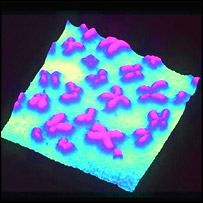
Gene regulation could be more important than gene number
|
Human beings have far fewer genes than originally thought, a consortium of scientists has claimed in Nature. The researchers compared the draft human genome with the "gold standard" version, published last year, to work out how they are different.
They found the most up-to-date human genome contains only 20,000 to 25,000 genes - which is about 10,000 less than indicated in the draft.
This suggests that gene regulation is far more important than gene number.
"It means that each gene can be used in a variety of different ways depending on how it is regulated," said Dr Tim Hubbard, of the Human Genetics group at the Sanger Institute in Cambridge, UK.
"The big thing is regulation."
Modest materials
Genes are the DNA starting templates that code for proteins, which then build and maintain our bodies.
When the draft human genome was published in 2000, and researchers estimated it contained between 30,000 and 40,000 genes, many people were surprised that something as complex as the human body could be built from such a modest number of tools.
Now the gene number has been revised downwards even further, and scientists suspect that the key to complexity lies not in the genes, but in the gaps between them. They are gradually discovering that the way genes are controlled - how, when and where they are activated - is a magnificently important and intricate process.
It is as if each gene were a Swiss army knife - they can do several jobs, depending on how they are handled.
At the moment the puppet masters, the bits of DNA that control the genes, are something of an enigma.
"There may be a whole lot of stuff in the genome that we just don't know how to extract yet," said Dr Hubbard. "There is a big international collaboration trying to find out what there is apart from protein coding genes.
"The genome contains tiny regulatory sequences, and these little 'actors' are important in the control system - but they are extremely hard to spot."
Pufferfish genome
In a separate development, scientists have sequenced a second pufferfish genome.
 |
THE DNA MOLECULE
The double-stranded DNA molecule is held together by four chemical components called bases
Adenine (A) bonds with thymine (T); cytosine(C) bonds with guanine (G)
Groupings of these "letters" form the "code of life"; there are about 2.9 billion base-pairs in the human genome wound into 24 distinct bundles, or chromosomes
Written in the DNA are about 20-25,000 genes which human cells use as starting templates to make proteins; these sophisticated molecules build and maintain our bodies
|
The near-complete sequence of the spotted green pufferfish, Tetraodon nigroviridis, was also published in the journal Nature. Scientists had previously sequenced the genome of the poisonous Japanese pufferfish Takifugu rubripes.
Tetraodon's 21 chromosomes, which together contain more than 300 million letters of DNA, tell a twisting evolutionary tale, and even shed light on our own genetic make-up.
By matching the genes on the pufferfish chromosomes to related genes on human chromosomes, the authors were able to peer into the genome of our shared ancestor - a primitive bony fish that lived hundreds of millions of years ago.
Tetraodon's genome is interesting because it is about one sixth the size of ours, even though it has a similar number of genes.
This means it has less of the "shady" DNA that hides in the gaps between genes - the very stuff that scientists are puzzling over in the human genome.
Quite why the pufferfish can do without it, while humans and other mammals apparently cannot, is something of a mystery.


~RS~q~RS~~RS~z~RS~55~RS~)